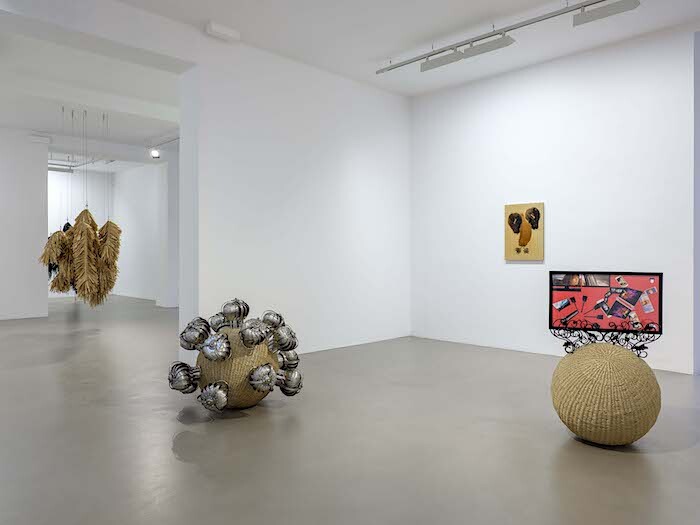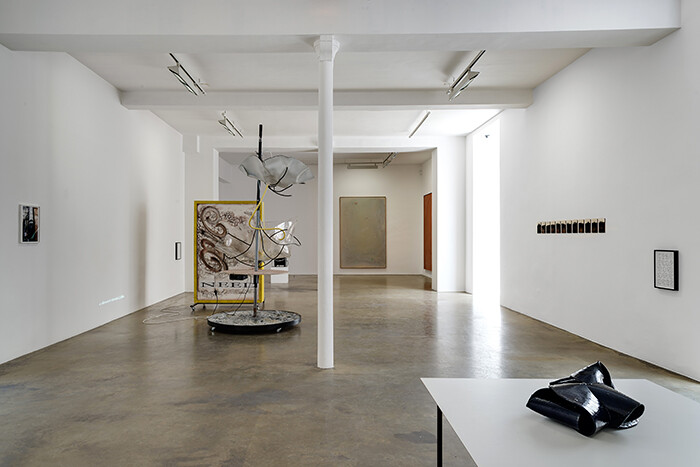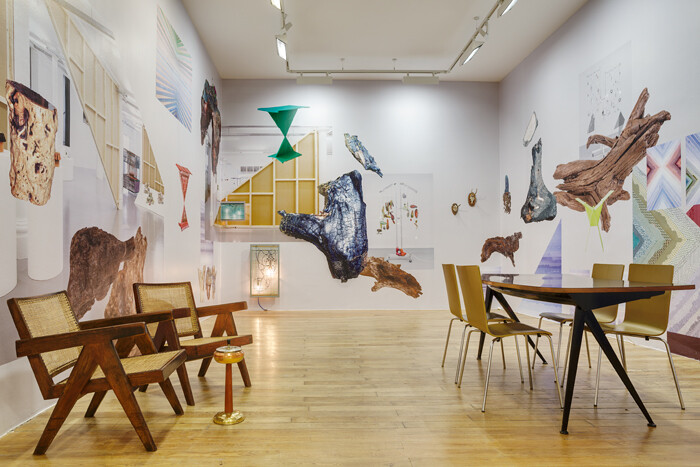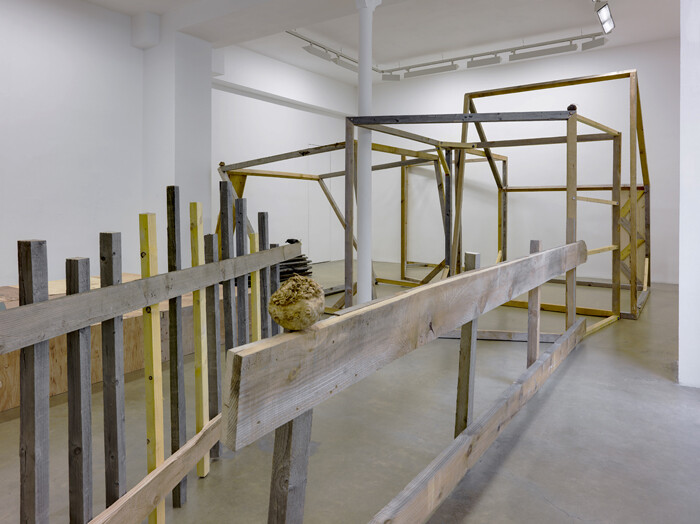Categories
Subjects
Authors
Artists
Venues
Locations
Calendar
Filter
Done
December 1, 2017 – Review
Haegue Yang’s "Quasi-ESP"
Sofia Lemos

Not having a story to tell from the beginning or possibly starting from the middle is how Taoism describes time: continuity without a starting point. Stories abbreviate and expand in “intensiveness,” a term Haegue Yang uses, in dialogue with Jimmie Durham, to describe a mode that, similarly to belief, can exist beyond linear narrative form. Yang, who is recognized for her forays into domesticity and response to the assumed neutrality of exhibition spaces, seeks to find a home in the political, constructing spaces of being and belonging in an ever-recurring cycle of unbound histories and narrations.
While in her discourse Yang positions abstraction at the frontier of form, collapsing real and imaginary kinds of value (including that of the human body and technological gimmicks), her studio practice convolutes these tropes. This is the case with the series “Hardware Store Collages” (ongoing since 1994), where indexed images of hardware and quotidian electronic components are released from their functional context and framed as unfamiliar organic assemblages. At Chantal Crousel, Media Markt smartphones and Saturn Bluetooth speakers are the subject of compositions that intensify technological narratives of hybridity. Swaying Television Ball (2017) places a two-sided flat-screen monitor atop an exercise ball made with artificial …
July 21, 2014 – Review
"Dark Waters"
Sabrina Tarasoff

The sea is said to speak to us in an amalgam of mysterious and alluring analogies, which are drawn from its depths and, at times, swallowed all too easily by the contemplative desires of artists, poets, and theorists alike. The metaphors are countless, yet invariable—from the reflective surfaces of still pools to the boundless temperaments of open seas. However, such romanticized figures of speech would seem to have capsized with the onslaught of post-industrial capitalism and its concomitant economies, giving way to more intangible seascapes, which present information, knowledge, and research as equally boundless and immersive landscapes.
In literary scholar Armelle Barguillet-Hauteloire’s book on the work of French author Marcel Proust, Proust et le miroir des eaux: Ou le thème de l’eau dans La Recherche du Temps Perdu [Proust and the Reflecting Waters: Or, the Theme of Water in In Search of Lost Time], the significance of allegorical self-reflectivity is rescued at sea, so to speak. In her reading of Proust’s 1913–27 novel, which the press release of Galerie Chantal Crousel’s recent exhibition cites, Barguillet-Hauteloire suggests that research mimics water’s capacity to mirror the world as a reflection of the reader’s life—much like water operates as a frequent trigger for memory …
April 17, 2013 – Review
Haegue Yang’s “Ovals and Circles”
Mara Hoberman

Hot on the heels of her first solo exhibition with Chantal Crousel (“Ajar” at the gallerist’s satellite showroom, La Douane, October 18–December 7, 2012), Haegue Yang’s current show at Crousel’s flagship gallery moves beyond the venetian blind installations and drying rack sculptures for which the South Korean-born, Berlin-based artist is best known. These signature works, however, do make a two-dimensional cameo in photographic wallpaper—a collaboration with designer Manuel Raeder—that covers three walls at one end of the gallery. Field of Teleportation (2011) is a disorienting digital collage combining installation shots from Yang’s past exhibitions with not-to-scale images of individual works. Domesticized with a pair of easy chairs, a standing ashtray, and a dining table set, this room is a habitable microcosm of Yang’s oeuvre. The only actual sculpture in the room is a small venetian blind in a powdercoated steel frame installed low on the wall, just beneath its own photographic image. Manteuffelstrasse 112 – Single and Solid (bathroom radiator) (2010)—a window/radiator hybrid—reacquaints the viewer with Yang’s alternate reality wherein useful household items are reborn as nonfunctional curios. But apart from a sculpture/bench made from nine colorful vintage side tables (Facilitating Pentagon Seating [2013]), Yang’s latest works appear freed from …
July 22, 2011 – Review
Anri Sala
Vivian Sky Rehberg

Guests were asked to bring their sturdy invitation cards, perforated with a code containing four seconds of music (Invitations, 2011) to Anri Sala’s opening at Galerie Chantal Crousel. Throughout the evening, those cards were fed into a barrel organ in the courtyard, which played familiar notes in a discordant fashion. Shortly after I arrived and handed over my card, a few older fellows toting brass instruments joined the festive crowd from off the street and all but overwhelmed the tunes eking out of the organ. It was only when these two musical cultures began to spar that the title of Sala’s chosen song hit me: “Should I Stay or Should I Go” by The Clash.
Perhaps then, it’s no wonder that the word “clash” has stuck in my head, just like the band’s refrain, with respect to the body of work presented here. Sala’s show is one where chance and orchestration collide, and one that mobilizes our senses in order to attune us to questions of space and place, beginning with a most basic contrast: to the left of the entrance, the space is darkened; to the right, it is fully lit. Drawn to the dark side, one finds two works …
November 3, 2010 – Review
Abraham Cruzvillegas’s "La Petite Ceinture" at Galerie Chantal Crousel, Paris
Chris Sharp

When you consider that Devo stands for “devolution”—the band’s neologism for the dysfunctional, herd mentality of modern society—you begin to get a sense of the dialectical complexity that underpins Abraham Cruzvillegas’s exhibition. Among the handful of curios that can be found in the voluminous, photocopy publication that accompanies this exhibition are a couple of black-and-white thumbnail images of the band Devo. Now it might not be immediately apparent what an iconic new wave band has to do with a subjective investigation of the industrialized version of medieval, fortified walls, otherwise known as la petite ceinture (“the little belt way”) in Paris. (But perhaps Devo’s ground-breaking geekdom can only but inform the unstable inside-outside binary essentially at stake here.)
For the artist’s first solo exhibition at Galerie Chantal Crousel, he has filled the entire main gallery space with a circular, quasi-architectural construction, made exclusively of found materials such as scraps of wood. The open, somewhat labyrinthine, structure is at once reminiscent of a skeletal favela, a modernist stage set design or, finally, a rather vast, wonky, constructivist sculpture. Its transparent construction and seemingly ramshackle composition represent both a symbolic ideal of interior-exterior porosity and a practical reality of fabrication, indissociable from the …